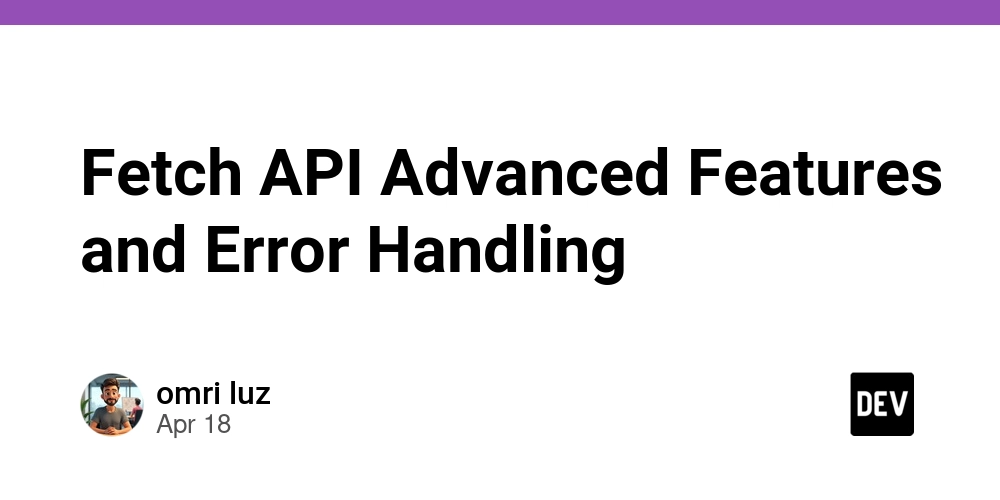Fetch API Advanced Features and Error Handling
Fetch API Advanced Features and Error Handling Introduction The Fetch API represents a modern approach to making network requests in JavaScript, introduced with the advent of Service Workers and more lightweight XMLHttpRequest alternatives. It allows developers to interact with servers using Promises and provides a powerful interface for managing both requests and responses. This article aims to delve deep into the Fetch API's advanced features, error handling mechanisms, and best practices. We will explore historical context, significant use cases in industry-standard applications, compare Fetch against alternatives, and consider performance optimization and debugging techniques among other advanced nuances that will serve experienced developers well. Historical and Technical Context The introduction of the Fetch API in 2015 marked a significant evolution in JavaScript’s approach to HTTP requests and asynchronous programming. Before Fetch, developers primarily relied on XMLHttpRequest (XHR), which was cumbersome, utilized callbacks, and had a less intuitive interface for handling responses when compared to the promise-based Fetch API. Promises: The Foundation of Fetch The Fetch API leverages JavaScript’s Promise-based architecture, allowing for cleaner, more maintainable asynchronous code: fetch(url) .then(response => response.json()) .then(data => console.log(data)) .catch(error => console.error('Error:', error)); Since its debut, Fetch has been widely adopted, but it’s crucial to understand its intricacies, notably error handling, stream handling, and advanced configuration options. Fetch API Syntax The Fetch API provides a fetch function that returns a Promise. Its basic syntax is as follows: fetch(url, options) url: The resource you wish to fetch. options: An optional object that can include method, headers, body, mode, credentials, cache, redirect, referrer, referrerPolicy, integrity, and keepalive. Example of a Basic Fetch Request fetch('https://api.example.com/data', { method: 'GET', headers: { 'Content-Type': 'application/json', }, }) .then(res => res.json()) .then(data => console.log(data)) .catch(err => console.error('Fetch error:', err)); In-Depth Code Examples Customizing Requests with Options The Fetch API allows substantial customization via the options parameter. For example, sending a POST request with a JSON body can be achieved as follows: const url = 'https://api.example.com/data'; const bodyData = { name: 'John Doe', age: 30, }; fetch(url, { method: 'POST', headers: { 'Content-Type': 'application/json', }, body: JSON.stringify(bodyData), }) .then(response => { if (!response.ok) { throw new Error('Network response was not ok: ' + response.statusText); } return response.json(); }) .then(data => console.log('Post successful:', data)) .catch(error => console.error('Fetch error:', error)); Handling Streams Additionally, Fetch supports streaming responses, which can be particularly useful for large payloads. This can allow processing of data as it is received: fetch('https://api.example.com/large-data') .then(response => { const reader = response.body.getReader(); return new ReadableStream({ start(controller) { function push() { reader.read().then(({ done, value }) => { if (done) { controller.close(); return; } controller.enqueue(value); push(); }); } push(); } }); }) .then(stream => { const reader = stream.getReader(); // Now you can work with the stream. return new Response(stream); }) .then(response => response.text()) .then(data => console.log(data)) .catch(error => console.error('Fetch error:', error)); Advanced Error Handling Handling errors in network requests goes beyond simply checking for the response's OK status. The Fetch API does not reject the Promise on HTTP error statuses (e.g., 404, 500), which requires explicit checks. Combine this with custom error handling logic to create robust applications. Example of Advanced Error Handling async function fetchData(url) { try { const response = await fetch(url); if (!response.ok) { // Handle different error statuses switch (response.status) { case 404: throw new Error('Resource not found'); case 500: throw new Error('Internal Server Error'); default: throw new Error('Unknown error occurred'); } } const data = await response.json(); return data; } catch (error) { console.error('Fetch error:', error); } } Edge Cases When designing applications, consider edge cases such as network failures, timeouts, CO

Fetch API Advanced Features and Error Handling
Introduction
The Fetch API represents a modern approach to making network requests in JavaScript, introduced with the advent of Service Workers and more lightweight XMLHttpRequest alternatives. It allows developers to interact with servers using Promises and provides a powerful interface for managing both requests and responses. This article aims to delve deep into the Fetch API's advanced features, error handling mechanisms, and best practices.
We will explore historical context, significant use cases in industry-standard applications, compare Fetch against alternatives, and consider performance optimization and debugging techniques among other advanced nuances that will serve experienced developers well.
Historical and Technical Context
The introduction of the Fetch API in 2015 marked a significant evolution in JavaScript’s approach to HTTP requests and asynchronous programming. Before Fetch, developers primarily relied on XMLHttpRequest (XHR), which was cumbersome, utilized callbacks, and had a less intuitive interface for handling responses when compared to the promise-based Fetch API.
Promises: The Foundation of Fetch
The Fetch API leverages JavaScript’s Promise-based architecture, allowing for cleaner, more maintainable asynchronous code:
fetch(url)
.then(response => response.json())
.then(data => console.log(data))
.catch(error => console.error('Error:', error));
Since its debut, Fetch has been widely adopted, but it’s crucial to understand its intricacies, notably error handling, stream handling, and advanced configuration options.
Fetch API Syntax
The Fetch API provides a fetch function that returns a Promise. Its basic syntax is as follows:
fetch(url, options)
-
url: The resource you wish to fetch. -
options: An optional object that can include method, headers, body, mode, credentials, cache, redirect, referrer, referrerPolicy, integrity, and keepalive.
Example of a Basic Fetch Request
fetch('https://api.example.com/data', {
method: 'GET',
headers: {
'Content-Type': 'application/json',
},
})
.then(res => res.json())
.then(data => console.log(data))
.catch(err => console.error('Fetch error:', err));
In-Depth Code Examples
Customizing Requests with Options
The Fetch API allows substantial customization via the options parameter. For example, sending a POST request with a JSON body can be achieved as follows:
const url = 'https://api.example.com/data';
const bodyData = {
name: 'John Doe',
age: 30,
};
fetch(url, {
method: 'POST',
headers: {
'Content-Type': 'application/json',
},
body: JSON.stringify(bodyData),
})
.then(response => {
if (!response.ok) {
throw new Error('Network response was not ok: ' + response.statusText);
}
return response.json();
})
.then(data => console.log('Post successful:', data))
.catch(error => console.error('Fetch error:', error));
Handling Streams
Additionally, Fetch supports streaming responses, which can be particularly useful for large payloads. This can allow processing of data as it is received:
fetch('https://api.example.com/large-data')
.then(response => {
const reader = response.body.getReader();
return new ReadableStream({
start(controller) {
function push() {
reader.read().then(({ done, value }) => {
if (done) {
controller.close();
return;
}
controller.enqueue(value);
push();
});
}
push();
}
});
})
.then(stream => {
const reader = stream.getReader();
// Now you can work with the stream.
return new Response(stream);
})
.then(response => response.text())
.then(data => console.log(data))
.catch(error => console.error('Fetch error:', error));
Advanced Error Handling
Handling errors in network requests goes beyond simply checking for the response's OK status. The Fetch API does not reject the Promise on HTTP error statuses (e.g., 404, 500), which requires explicit checks. Combine this with custom error handling logic to create robust applications.
Example of Advanced Error Handling
async function fetchData(url) {
try {
const response = await fetch(url);
if (!response.ok) {
// Handle different error statuses
switch (response.status) {
case 404:
throw new Error('Resource not found');
case 500:
throw new Error('Internal Server Error');
default:
throw new Error('Unknown error occurred');
}
}
const data = await response.json();
return data;
} catch (error) {
console.error('Fetch error:', error);
}
}
Edge Cases
When designing applications, consider edge cases such as network failures, timeouts, CORS issues, and unexpected data formats. The AbortController API works seamlessly with Fetch to handle timeouts and cancellation:
const controller = new AbortController();
const signal = controller.signal;
fetch('https://api.example.com/data', { signal })
.then(response => response.json())
.then(data => console.log(data))
.catch(error => {
if (error.name === 'AbortError') {
console.error('Fetch aborted');
} else {
console.error('Fetch error:', error);
}
});
// Abort after 5 seconds
setTimeout(() => controller.abort(), 5000);
Performance Considerations and Optimization Strategies
When dealing with the Fetch API, particularly in high-performance or production scenarios, consider the following:
-
Batch Requests: Instead of sending multiple requests sequentially, which can increase latency, consider using
Promise.all()for concurrent requests.
const urls = [
'https://api.example.com/resource1',
'https://api.example.com/resource2',
];
Promise.all(urls.map(url => fetch(url)))
.then(responses => Promise.all(responses.map(res => res.json())))
.then(data => console.log(data))
.catch(error => console.error('Fetch error:', error));
Caching Strategies: Implement custom caches (using
Cache API) for frequently accessed resources to minimize network requests. Take advantage ofservice workersto intercept requests and serve cached responses.Compression: Ensure your server is configured to use content encoding like Brotli or Gzip to reduce payload size.
Comparison with Alternatives
While Fetch is now dominant, understanding its competitors helps make informed decisions:
- XMLHttpRequest (XHR): Older but allows for synchronous requests, which are not possible with Fetch.
- Axios: A promise-based HTTP client that provides a rich set of features, including handling JSON transformations, intercepting requests and responses, and automatic array buffering.
Here’s a comparison based on features:
| Feature | Fetch | XHR | Axios |
|---|---|---|---|
| Promise-based | Yes | No | Yes |
| Interceptors | No | No | Yes |
| Request/Response timeout | No | Yes | Yes |
| Automatic JSON handling | No | No | Yes |
| Upload/Download progress | No | Yes | Yes |
Use Cases from Industry-Standard Applications
Many modern applications leverage the Fetch API for its simplicity and versatility:
- Single Page Applications (SPAs): Frameworks like React and Vue often use Fetch for data fetching, providing seamless integration with component lifecycle methods.
- Progressive Web Apps (PWAs): Fetch is indispensable in PWAs for offline capabilities through service workers, using the Cache API for resource management.
Advanced Debugging Techniques
Debugging Fetch-related issues can be challenging given that they often occur asynchronously and outside the immediate code execution path. Here are techniques that can aid:
- Network Tab: Use the Developer Tools' Network tab to analyze request/response headers and bodies.
- Verbose Logging: Incorporate logging at various stages of the request/response cycle to trace where things might be failing.
async function fetchWithLogging(url) {
console.log(`Fetching URL: ${url}`);
const response = await fetch(url);
console.log(`Status: ${response.status}`);
return response;
}
- Error Boundaries: In UI frameworks, implement error boundaries to catch and log Fetch errors.
Conclusion
The Fetch API is a powerful tool for managing HTTP requests in JavaScript. Through understanding its advanced features, robust error handling techniques, and optimal usage patterns, developers can harness its full potential. From performance tuning to embracing modern development patterns, such as Promises and async/await, all aspects of the Fetch API contribute significantly to building efficient, scalable applications.
This article serves as a comprehensive guide to harnessing the Fetch API's capabilities, offering insights that are invaluable to intermediate and senior developers alike. As the web continuously evolves, staying current with such techniques will ensure that you’re creating applications that are not only functional but also performant and user-centric.
References
- MDN Web Docs: Fetch API
- MDN Web Docs: Using Fetch
- MDN Web Docs: Service Workers
- What you need to know about XMLHTTPRequest vs Fetch
- Guide to Using Axios in React
This in-depth exploration should empower you to confidently utilize the Fetch API in complex and real-world applications, as well as become adept at navigating its nuances and ensuring high performance.


.jpg)

























![[Webinar] AI Is Already Inside Your SaaS Stack — Learn How to Prevent the Next Silent Breach](https://blogger.googleusercontent.com/img/b/R29vZ2xl/AVvXsEiOWn65wd33dg2uO99NrtKbpYLfcepwOLidQDMls0HXKlA91k6HURluRA4WXgJRAZldEe1VReMQZyyYt1PgnoAn5JPpILsWlXIzmrBSs_TBoyPwO7hZrWouBg2-O3mdeoeSGY-l9_bsZB7vbpKjTSvG93zNytjxgTaMPqo9iq9Z5pGa05CJOs9uXpwHFT4/s1600/ai-cyber.jpg?#)












































































































































![[The AI Show Episode 144]: ChatGPT’s New Memory, Shopify CEO’s Leaked “AI First” Memo, Google Cloud Next Releases, o3 and o4-mini Coming Soon & Llama 4’s Rocky Launch](https://www.marketingaiinstitute.com/hubfs/ep%20144%20cover.png)





























































































































![[FREE EBOOKS] Machine Learning Hero, AI-Assisted Programming for Web and Machine Learning & Four More Best Selling Titles](https://www.javacodegeeks.com/wp-content/uploads/2012/12/jcg-logo.jpg)








































































![Rogue Company Elite tier list of best characters [April 2025]](https://media.pocketgamer.com/artwork/na-33136-1657102075/rogue-company-ios-android-tier-cover.jpg?#)








































































_Andreas_Prott_Alamy.jpg?width=1280&auto=webp&quality=80&disable=upscale#)






























































































![What’s new in Android’s April 2025 Google System Updates [U: 4/18]](https://i0.wp.com/9to5google.com/wp-content/uploads/sites/4/2025/01/google-play-services-3.jpg?resize=1200%2C628&quality=82&strip=all&ssl=1)










![Apple Watch Series 10 Back On Sale for $299! [Lowest Price Ever]](https://www.iclarified.com/images/news/96657/96657/96657-640.jpg)
![EU Postpones Apple App Store Fines Amid Tariff Negotiations [Report]](https://www.iclarified.com/images/news/97068/97068/97068-640.jpg)
![Apple Slips to Fifth in China's Smartphone Market with 9% Decline [Report]](https://www.iclarified.com/images/news/97065/97065/97065-640.jpg)
































































































































